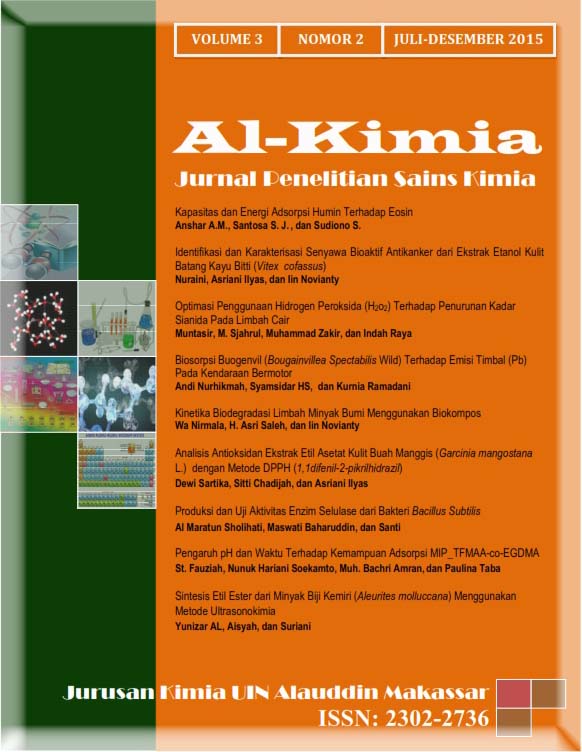Identifikasi dan Karakterisasi Senyawa Bioaktif Antikanker dari Ekstrak Etanol Kulit Batang Kayu Bitti (Vitex cofassus)
Abstrak
Bitti wood (Vitex cofassus) is one of the plants in Verbenaceae family and known by the people of South Sulawesi as the building material. The aims of this research is to identify and characterize the anticancer bioactive compound in ethanol extract of vortex Bitti wood (Vitex cofassus) and to determine the bioactivity value. This research uses extraction and fraction method, identification uses thin layer chromatography (TLC) and phytochemical test to know metabolism secunder and characterization with FTIR. The result from isolation shows that the amorf shape with 18 mg has white and yellow colour. The purification is conduted by using spectroscopy test FTIR. The result shows that the crystal has flavonoids compound which is solid with phytochemical test like positive product by using FeCl3 5%, NaOH 10% and H2SO4 P. Thick extract, fraction combination and amorf continued with toxicity test with the animal test Artemia salina Leach it uses Brine Shrimp Lethality test (BST) method. LC50 value which is gotten the three samples is thick extract 29,51 ppm, combination fraction 169,82 ppm and amorf 562,34 ppm.
##plugins.generic.usageStats.downloads##
Referensi
Agus, G., 2007, Teknologi Bahan Alam, Bandung: ITB.
Bertomi R. P., 2011, Uji Toksisitas Akut Ekstrak Kulit Batang Pulasari (Alyxiae cortex) dengan Metode Brine Shrimp Lethality Test (BST), Skripsi Sarjana, Program Studi Farmasi Fakultas Farmasi Universitas Sanata Dharma Yogyakarta, h. 6.
Chasanah U, et.,al. Anti Cancer Pre-Screening for Several Plant Using Brine Shrimp Lethality Test, Jurnal Program Studi Farmasi Fakultas Ilmu Kesehatan Universitas Muhammadiyah Malang. h. 1.
Herna´ndez, M.M, et.,al, 1999, Biological activities of crude plant extracts from Vitex trifolia L. (Verbenaceae), J. of Ethnopharmacol Jurnal.
Firdaus, 2011, Laporan Hibah Penulisan Buku Ajar Teknik dalam Laboratorium Kimia Organik. Makassar: Unhas.
Ikawati, M., et., al. Pemanfaatan Benalu Sebagai Agen Antikanker, Jurnal. h. 1.
Jayanti N. W., et., al, 2012, Isolasi dan Uji Toksisitas Senyawa Aktif dari Ekstrak Metilena Klorida (MTC) Lengkuas Putih (Alpinia galanga (l) willd), Chem. Prog,. 5 (2):102.
Kamilah E. H. dan Nurhalimah, 2010, Pytochemical Test and Brine Shrimp Lethality Test Against Artemia salina Leach of Anting-Anting (Acalypha indica Linn) Plant Extract, Alchemy, 1(2) : 81.
Li, W.X, et.,al, 2005, Flavonoids from Vitex trifolia Inhibit Cell Cycle Progression at G2/M phase and Induce Apoptosis in Mammalian Cancer Cells, J Asian Nat, h. 615.
Lisdawati V., Sumali W. L. Broto S. K., 2006, Brine Shrimp Lethality Test (BSLT) dari Berbagai Fraksi Ekstrak Daging Buah dan Kulit Biji Mahkota Dewa (Phaleria macrocarpa), Bul. Penel. Kesehatan, 34 (3), h. 112.
Muaja, D. A., Harry S. J. K. dan Max R. J. R., 2013, Uji Toksisitas dengan Metode BSLT dan Analisis Kandungan Fitokimia Ekstrak Daun Soyogik (Saurauia bracteosa DC) dengan Metode Soxhletasi, Jurnal MIPA Unsrat Online, 2 115-118 h. 115.
Nurhayati A. P. D., Nurlita A. dan Rachmat F., 2006, Uji Toksisitas Ekstrak Eucheuma Alvarezii terhadap Artemia Salina sebagai Studi Pendahuluan Potensi Antikanker, Akta Kimindo, 2 (1) : 118.
Olowa , L. F. dan Olga M. N., 2013, Brine Shrimp Lethality Assay of the Ethanolic Extracts of Three Selected Species of Medicinal Plants from Iligan City, Philippines, International Research Journal of Biological Sciences, 2(11): 74-77, ISSN 2278-3202.
Prasetyawati, A., 2013, “Eksplorasi Benih Bitti (Vitex Cofassus) Di Sulawesi Selatan”.
Raina, 2011, Tanaman Obat Untuk Kesehatan. Yogyakarta: Absolut.
Rolliana R. E., 2010, Uji Toksisitas Akut Ekstrak Etanol Daun Kamboja Skrining Awal Ekstrak Etanol Daun Kamboja (Plumeria alba l.) terhadap Larva Artemia Salina leach dengan Metode Brine Shrimp Lethality test (BST), Artikel Karya Tulis Ilmiah.
Authors who publish with this journal agree to the following terms:
1) Authors retain copyright and grant the journal right of first publication with the work simultaneously licensed under a Creative Commons Attribution License that allows others to share the work with an acknowledgement of the work's authorship and initial publication in this journal.
2) Authors are able to enter into separate, additional contractual arrangements for the non-exclusive distribution of the journal's published version of the work (e.g., post it to an institutional repository or publish it in a book), with an acknowledgement of its initial publication in this journal.
3)Authors are permitted and encouraged to post their work online (e.g., in institutional repositories or on their website) prior to and during the submission process, as it can lead to productive exchanges, as well as earlier and greater citation of published work (See The Effect of Open Access).


